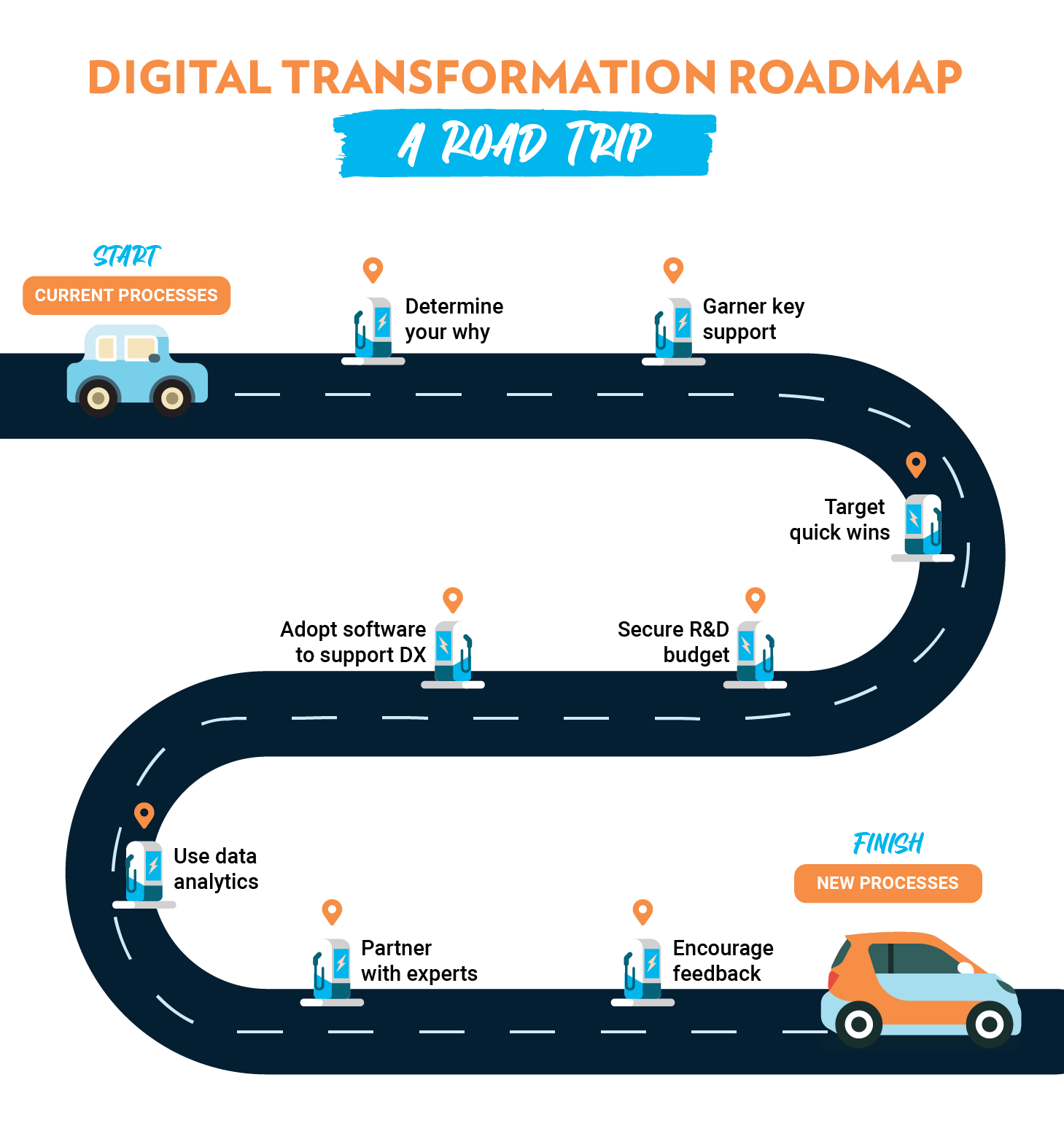- Blog
- 8 steps to a successful digital transformation roadmap
8 steps to a successful digital transformation roadmap

Amid those thousands of words though, a quote from one man stands out from the crowd. As a technology expert and keynote speaker, Chilean Juan Pablo Rozas has spent more than a decade helping companies and public bodies overcome their digital challenges. With the ability to communicate complex ideas in simple terms and multiple languages, he is also the author of Digital Transformation Is Not Digital and has pinpointed why so many businesses fail when tackling DX.
“Just implementing technology alone does not produce a digital transformation,” Rozas said. “Changing an organisation by taking advantage of the potential of technologies does.”
No doubt that quote will resonate with many readers, those of you have watched with frustration as executives and managers talk up their ‘digital transformation strategies’ and ‘roadmaps for digital transformation’ and deliver little more than a new cloud-based server and upgrade of the office computers.
As Rozas says, that is not digital transformation. True digital transformation is about reimagining how an organisation does business with digital technology at the forefront of mind. From creating new business processes to enhancing team culture and customer experiences, it is an opportunity to use technologies to drive fundamental change that increases efficiencies, improves agility and ultimately delivers new value for employees, customers and shareholders.
It is also a journey and, like any great journey, a road map can come in very handy.

What is a digital transformation roadmap?
A digital transformation roadmap is a strategic blueprint designed to guide your organisation's transition from its current digital processes to planned new digital processes. It serves as a navigational tool, akin to planning a road trip, where you map out the journey from your current state to your desired destination, outlining the steps necessary to bridge the gap effectively. Too much language when it comes to digital transformation roadmaps is unnecessarily complicated when it could be summed up as simply as:
“A digital transformation roadmap is a plan to get your organisation from using your current digital process to using a new digital process.”
That’s right – as with other roadmaps, it’s all about creating a clear and concise route for how to get from Point A to Point B and that requires organisations to take stock of where they are now, where they want to be in the future and do their best to bring everyone along for the ride.
In the spirit of keeping things simple, this would be a good point to note how digital transformation differs from two other D-words you are likely to encounter on your own journey. ‘Digitisation’ and ‘digitalisation’ play crucial roles in the digital transformation process but they are certainly not one and the same.
Digitisation – the move from analogue to digital
This may be a mind-blowing concept for younger readers but there was a time when businesses kept all their records on paper. Some were handwritten in ledgers, others typed into documents and all were filed away for safekeeping. Then, if a team member wanted to gather or share information, they had to find the physical paperwork and prepare it accordingly. Of course, the dawn of the computer age changed everything and we now live in a world where new documents and files are stored electronically – but what about all that old paperwork? Enter digitisation - the process of converting analogue information and data into digital computer files. Examples include scanning a photo or recreating a ledger in Excel and while it is a time-consuming process, the benefits come when that information is available at the touch of a keypad.
Digitalisation – simplifying work using digital data
Let’s start by saying what digitalisation is not. It is not using digital technology to change how you do business or create new types of businesses. Rather, digitalisation is when you use digitised information to make established systems and processes simpler and more efficient. Once upon a time, data was tucked away in a physical filing cabinet or archive. Now, thanks to digitisation, such material can be easily and quickly accessed via computers or mobile devices, making the likes of resolving customer enquiries or studying sales trends much faster. When it comes to digitalisation, the basic business process has not changed – just the efficiency and speed that it is completed.
Which leads us to digital transformation and the pursuit of not just doing old tasks faster but exploring entirely new opportunities. Whether changing the way business gets done or creating new categories of business altogether, digital transformation requires a definitive step away from traditional ways and toward more experimentation and creative thinking – and creating a comprehensive digital transformation strategy can be a game-changer.

8 steps to a quality digital transformation strategy
As should be clear by now, digital transformation initiatives are all well and good but long-term rewards will only be reaped on the back of a coordinated digital transformation strategy. A survey of executives found more than a third of them believe the lack of a clear transformation is a key barrier to their business achieving its full digital potential. To avoid adding to that number, consider these key steps when developing your own road map.
- Determine your ‘why’: too many organisations make the mistake of rushing to embrace new technologies and only in hindsight consider why they wanted to implement them in the first place. To get your digital transformation off on the right foot, start by identifying your business needs and goals. What do you want to achieve in the short term? Where do you see the business in a decade? What is the main work issue causing headaches and are new markets on the radar? Asking such questions early in the process is a great foundation from which to build a digital transformation strategy. In a similar vein, take into account your organisation’s current vision and strategic goals to ensure any digital transformation process aligns with them. Remember digital transformation is not a one-off project – it is a strategic priority that can position an organisation for a better future.
- Garner key support: the days of IT managers needing to fight their way into corporate boardrooms are well and truly in the past, with research showing oversight of digital transformation has shifted almost exclusively to C-suite executives. One study found almost 90% of businesses now see the likes of their CEOs, COOs and CIOs as part of DX strategy and budget ownership, up from only 36% in 2019. This is a huge win as C-suite support and enthusiasm is crucial for any cultural change to be successful. Large-scale change can be daunting for some people and it is inevitable there may be pushback, which is why having key executives onboard can make a world of difference. At the other end of the ladder, identifying colleagues who can act as digital transformation advocates will also reap rewards. Arming them with the information they need to understand the benefits of digital transformation will help ensure long-term support.
- Target quick wins: transformation does not happen overnight. It is a process that takes time and people need to commit for the long haul. That said, a way to ensure ongoing support is to identify an initial project or two that will achieve quick results and help attract additional support from leaders and teams. It is understandable to want to tackle a project that will deliver great return on investment but it may erode enthusiasm if it takes too long to be realised. A better option in the early stages of a digital transformation strategy is to search for quick wins that can be operational and show results in a few months and, in turn, help drive DX momentum. There is no more important digital transformation project than your first one as it will lay the foundation for long-term success.
- Secure R&D budget: the old saying goes that you need to spend money to make money and that is certainly the case with digital transformation. Research has shown companies that adapt to DX strategies can expect their revenues to grow within the next five years but the process has to start with capitalisation. Research and development ensure that businesses know the technology they are devising and deploying will make a positive impact and enable new IT systems and processes to reach their full potential. Involve as many team members as practical in the various stages of research and development as they will be able to best identify what is needed to improve overall efficiencies and take products and services to the next level.
- Adopt software to support DX: Change management tools can play a crucial role in making digital transformation run smoothly. While your DX strategy will introduce your team to new technologies, it is important to provide them with software and tools to help them navigate what can be an overwhelming period. One example is a digital adoption platform (DAP), which not only provides users with contextual guidance but allows them to learn as they work. Rather than sacrifice productivity, in-app guidance and walkthroughs enable them to gain knowledge ‘in the moment’. Other tools that support different aspects of digital transformation include:
- Feedback gathering tools that encourage employee engagement, idea sharing and the prioritisation of initiatives;
- Cloud-based collaborative suites (eg: Office 365) that allow employees to access data and resources at all times;
- CRM (Customer Relationship Management) systems that help companies understand and address the needs of customers, automate tasks, shorten sales cycles and increase retention; and
- Dedicated chat channels in tools like Slack that allow employees to ask questions and share tips related to the transformation.
- Use data analytics: in striving for a successful transformation journey, do not forget the role that cloud and data analytics can play. Sourcing data that shows patterns and trends and having it collated and analysed by computing systems can help identify areas of focus that will increase your business’s chances of success. Analysis of big data allows complex issues such as product demand and audience interaction to be studied effectively, with the findings able to then be used to run an organisation more efficiently.
- Partner with experts: digital transformation can be overwhelming, which is why finding the right technology partners is just as important as finding the right technology. If the people guiding you on your DX journey are not experienced or lack true knowledge, there will be headaches along the way. Don’t just look for technology partners who have the right technology at the right price. Factor in whether they connect with your digital transformation vision. You need them to complement your strengths and strengthen your weaknesses, along with boasting a genuine desire to accelerate results and drive innovation. Also don’t be afraid to make them answer the DX questions that are most important to you. After all, a true partner will relish the chance to prove their credentials.
- Encourage feedback: key support – tick. Financial investment – tick. Quality partners – tick. It’s now time to set the key performance indicators that will help ensure accountability and long-term results. Clearly defined KPIs and ensuring all involved know what is expected of them lies at the heart of any strategy and it is no different with digital transformation. Likewise, stakeholders should have every opportunity to share their thoughts on what is working and, more importantly, what is not. Implement a strong feedback system to ensure key learnings are shared and used to improve the overall experience as the digital transformation unfolds.

Digital transformation risks
Having inspired your digital transformation ambitions, it is now time for a reality check. Not everything goes to plan, not every innovation is a winner. Some organisations may fall behind on their DX journeys but they cannot afford to put them on the backburner. It is much better to identify potential risks and what is needed to stay on track. These include:
- Too much too soon: this may be hard to accept for businesses that feel they need to move quickly to embrace digital transformation but you need to do it in a way that gives you the greatest chance of success. The worst thing a company can do is overwhelm its customers, let alone its employees, with a swathe of digital innovations that are more about quantity than quality. Working in increments and having the ability to pivot as needed is a far better option.
- Staff attrition: there are few stronger signals that a digital transformation road map needs to be reviewed – and possibly re-engineered – than a staff exodus. Transformation is not solely about technology. It requires cultural change and the workplaces that boast the best success stories are those that boast the happiest employees. Ensure your DX strategy is underpinned by a culture centred on meaningful work, engaged employees and quality managers who foster a positive environment.
- Shooting too low: some executives make the mistake of restricting their digital efforts to pressing needs and fail to consider the bigger picture. While this approach may minimise costs, it fails to appreciate that digital transformation requires a greater vision than simply improving current processes. This is a particular risk in the current global pandemic as there has never been a more important time for leaders to be visionary because the business environment will look a lot different in a year or two than it does now.

Summary
Digital transformation is not a destination. It is not about ticking a few boxes to achieve a goal and move on to the next corporate challenge. It is a journey that requires ongoing commitment across all levels of an organisation as the only thing more certain than new technologies being rolled out is your competitors will be waiting to embrace them.
Digital tools such as intelligent virtual agents and robotic process automation are reinventing how we do business in the 21st century. Learn how to build an exceptional customer experience and improve CX processes across your organisation by designing, deploying and managing digital solutions customised to your unique needs.


